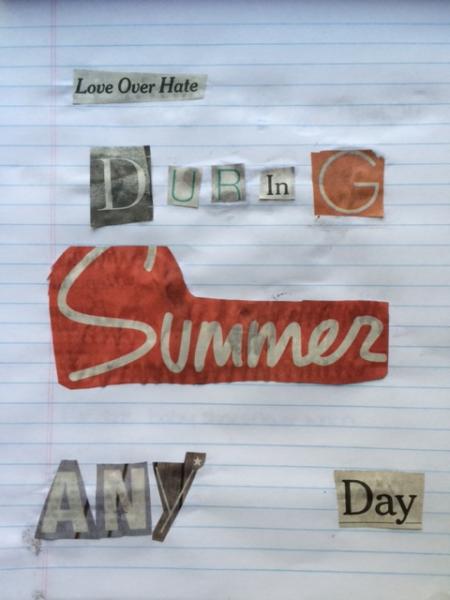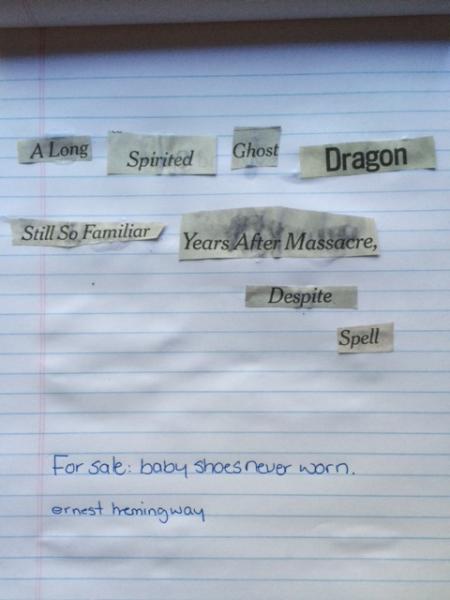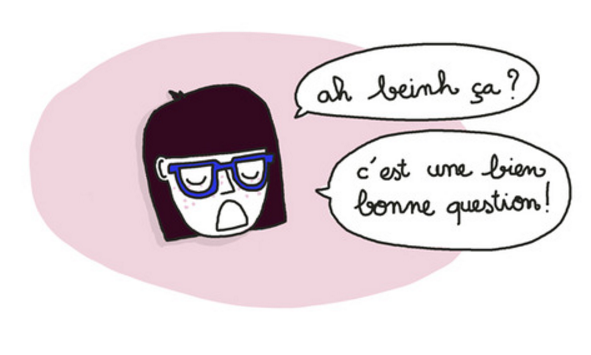Photo: Gaetan Nerincx
By Jeff Roy and Marie-Pierre Gadoua
Last summer, Exeko had the opportunity to hold a series of literature workshops at the PAQ Native shelter of Montreal. We decided to organise writing sessions, during which we would explore different ways of expressing ourselves and of developing our creativity with words.
In the first workshop, we warmed up with automatic writing, a method inspired by the surrealist movement in arts, literature and poetry. The idea was to write down every thought coming up in our minds, without any control, censorship, or restraint. Although it might seem easy to do, it was not. This exercise made us realise that we are very much conditioned by different forms of discipline when we write: discipline about the content, the syntax, punctuation, etc.
With automatic writing we let it all go; we set our minds and pencils free. After the exercise, we compared our creations with each other, and we could see how our thoughts flow differently, and we realised that they also transform differently into words. For many of us, this was an opportunity to free ourselves from the constraints that are self-imposed and that sometimes impede our process of creation.
“Abcdefghijklmnopqrstuvwxyz. Several suspicious snakes slowly slithered southwards. Several suspicious silver scaled snakes slowly slithered southwards. The leather feather withered in the rainy weather. Several suspicious silver scaled snakes slowly slithered southwards. The ground made a profound sound all around. The ground made a profound sound all around. The ground made a profound sound all around.” (Jeff Roy, playing with words during the automatic writing session)
For the second workshop, we did the exact opposite: we worked with the constraint of texts already written by others. Using newspapers from all over the world, we cut down words and segments to create new ones (see photos). Again, each participant created very different kinds of texts: humoristic, serious, dramatic, scary, political, poetic… Each participant’s personality and mood of the moment was tangible in the creations.


We also worked with a political text describing Aldous Huxley’s dystopic view of society (from the novel Brave New World), and we decided to re-write it in our own words. Some of us were so uncomfortable with the content of the text that we decided to invert its meaning, in a way to create our ideal view of society (changing the dyspotia into an utopia). Others took the difficult task to hold on to the original content and give it a personal literal twist.
“In order to prevent a rebellion, intimidation must be avoided. Allow the masses a certain amount of enticing liberties, which can only be considered as privileges. Restrict individual desire towards progression of both biological and intellectual tendencies. A multitude of remedial distractions interloped with limited access for procuring sustainable stability, simultaneously establishing a steadily growing gap between classes. Ridicule and emphasize specific profitable concepts within all forms of public media. Indirectly persuade people to reject notions of any form of self-conscious awareness through comical media. Emphasizing on playful or lethargic tendencies. Inebriation must be reinforced within the fully developed domain, while suppressing any notion against the current social norm. When encountering any individual who may have developed a tolerance, immunity to most forms of persuasion, just simply offer wealth and a position of power.” (Jeff Roy, re-phrasing a philosophical text inspired by Huxley’s dystopia)
In our third workshop we wrote fiction stories, with narrative outlines and characters. We had to pick randomly three characters: one protagonist, one helper and one opponent. We also picked one physical and one psychological characteristic for each. Then we wrote a story, which had to happen in a specific place and time, with an initial situation, a trigger event, the rising action, a climax and a resolution. There were Native characters, non-Natives, animals, natural elements, stories from the past, in the future, brave and weak people... and most of all, there was the pleasure of creating stories and telling them to the other participants.
“While trodding through a dense forest, a young traveller unexpectedly stumbled upon an unusual clearing. The trees were hewn and discarded along the perimeter’s far side. The sun’s rays were scorching the old anthropologist’s back, with what felt as pure fury, while surveying the newly excavating site. Apparently, he presumed, there was evidence of an old gathering place, which was rumoured by some of the local Mohawk tribes. The anthropologist’s tall stature resembled his mentality, stern and impatient. Simultaneously, where the freshly discarded hewn trees laid, a Mohawk fur trader perched himself on a log while the excavation proceeded.” (Excerpt from Jeff Roy’s fiction text)
We also tested these different writing techniques at the Montreal Museum of Fine Arts, in the Inuit art gallery and with the paintings of Cree artist Kent Monkman. We practised our automatic writing, triggered by the visual observation of Inuit sculptures. This gave us a mixed sense of freedom (through the very act of automatic writing) and of constraint (the writing had to stem from our visual perception of the sculptures). Facing other forms of art, notably Monkman’s paintings, we wrote stories, narratives about the images we were looking at. These exercises were probably the hardest of all, because in front of such powerful works of art, our eyes didn’t want to stick to our papers and pencils: we just wanted to admire these masterpieces and talk about them. But instead, we disciplined ourselves, and wrote our thoughts about them. It was a way to honour the artists and their works, and to transform our perception of their art into a different form of creative expression, a written one.
“Je vois un morse en souliers modernes. Je vois aussi un peuple qui évolue au fil du temps.”
“Le joueur de tambour qui voit la musique à travers les esprits, qui partage les traditions d’avant, pour le futur, l’avenir.” (Christine Vachon)
Writing workshop at the PAQ Native Shelter of Montreal are part of the projet Libre-library.
Les ateliers d'écriture du PAQ (Projets Autochtones du Québec) s'inscrivent dans le cadre du projet Biblio-libre. Ce projet bénéficie du soutien financier du ministère de la Culture et des Communications et de la Ville de Montréal dans le cadre de l'Entente sur le développement culturel de Montréal.














 Laurier
Laurier